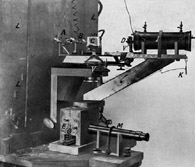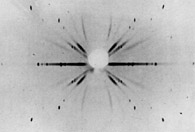
X-ray crystallography
1912
technique to determine atomic structure of crystals
Australian-born Lawrence Bragg won a Nobel Prize for opening up a very important field of research: using X-rays to examine the atomic structure of crystals. He shared the prize with his father, William, for work they did in Britain. So why can we claim this as an Australian innovation?
William Bragg studied maths in Britain before joining the staff of Adelaide University. Critically, he was appointed to teach physics as well as maths in a university that was short of apparatus. He apprenticed himself to a scientific instrument maker and soon began research into radio waves and X-rays. He discussed ideas with other local scientists, including New Zealander Ernest Rutherford (another Nobel Prize winner).
Lawrence Bragg studied maths at Adelaide University before going to Britain with his family. In 1912, he made a brilliant breakthrough, deriving a simple equation relating the angle that X-rays are deflected (bent) by a crystal to the distance between its neatly arrayed atoms. His father built an X-ray spectrometer and developed a new method to measure the ?angle of deflection?.
There is a strong argument that the time spent in Adelaide moulded the scientific interests and skills of both Braggs and so was crucial to their innovation.
William and Lawrence studied the structures of many crystals, including proteins. In mid-century, the development of penicillin as a useful antibiotic involved such studies. At the end of the century, the field of X-ray crystallography was still yielding significant results; for instance, an understanding of the structure of influenza proteins led to development of the flu drug Relenza.
Who Did It?
Key Organisations
University of Adelaide : fostered research interests
University of Leeds : first experiments in the area
Key People
Lawrence Bragg : theoretician and researcher
William Bragg : instrument-maker and researcher
Further Reading
Australian Dictionary of Biography
Melbourne University Press, 1979
S G Tomlin, joint entry for the Braggs (vol 7 pp 387-389)
Links
Biography
of Lawrence Bragg
Biography
of William Bragg
Crystallography
explained
Related Innovations
Penicillin
Relenza flu treatment
|











